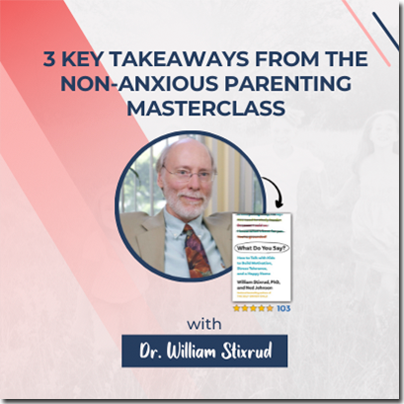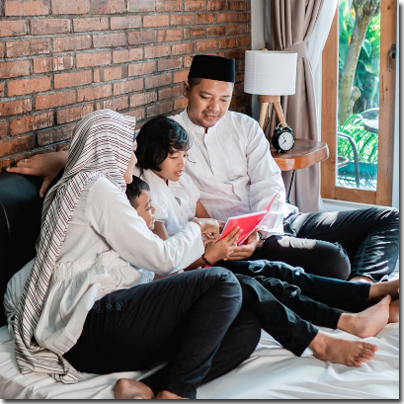 In less than a month, the fantastic and free Positive Parenting Conference 2022 will be available to parents and educators once again! As a member and writer for the AFineParent Academy, I was thrilled to be given early access to the Non-Anxious Parenting Masterclass with Dr. William Stixrud.
In less than a month, the fantastic and free Positive Parenting Conference 2022 will be available to parents and educators once again! As a member and writer for the AFineParent Academy, I was thrilled to be given early access to the Non-Anxious Parenting Masterclass with Dr. William Stixrud.
Dr. Stixrud is a co-author of What Do You Say? How to Talk with Kids to Build Motivation, Stress Tolerance and a Happy Home. He is a clinical psychologist, has a doctorate degree in educational psychology and is a faculty member at the Children’s National Medical Center.
I found this masterclass incredibly encouraging, especially now when child anxiety is at an all-time high. This session will resonate with many parents across the globe as so many of us have been impacted by similar challenges during the pandemic and shutdown that have contributed to increased anxiety.
In particular, I learned how best to respond when my instinct is to ‘fix’ whatever challenge my children are facing; how to encourage a non-anxious home environment by reducing unintentionally anxiety-inducing questions; and how to put exams into perspective and focus on the importance of living a fulfilled, meaningful life.
Without further ado, here are my top three takeaways!
#1: The Power of Reflective Listening
 Dr. Stixrud explains that the silver bullet that can help protect children against all kinds of mental health problems is a close relationship with parents. Dr. Stixrud has unfortunately also found that many teenagers feel closer to their friends than their parents because “they listen to me without judging me, and they don’t tell me what to do.”
Dr. Stixrud explains that the silver bullet that can help protect children against all kinds of mental health problems is a close relationship with parents. Dr. Stixrud has unfortunately also found that many teenagers feel closer to their friends than their parents because “they listen to me without judging me, and they don’t tell me what to do.”
In the masterclass, Dr. Stixrud discusses a number of ways to connect with our children including spending time together, developing family rituals and showing an interest in what they are into–even if that interest is video games that feel mind-numbing to us!
He talks about how our first instinct as parents is often to fix or lecture. I can relate to this as I feel stressed when my children are in pain, and I often catch myself trying to shoo those difficult emotions away. Dr. Stixrud emphasizes the importance of dropping this agenda and instead aiming to understand without judgement. He shares a useful acronym, SURE:
Stay calm
Understand
Reflect
Explore
I can identify with how important it is to take time to reflect as it not only allows us to check that we’ve understood, but it also allows our children to feel seen; it gives both us and our children time to process the situation before taking action.
When my daughter came back from school this week upset because someone in her class said something mean, I fought my instinct to defend and ‘fix’ it by messaging the girl’s parents. Instead, I took some deep breaths and concentrated on empathizing with my daughter with words such as “So you’re saying that… That would upset me too! I’m always here if you want to talk.”
And while a niggly part of me felt like I hadn’t been helpful enough, the next day my daughter had formulated her own plan for how to make things right and that was the last I heard of it. Following Dr. Stixrud’s suggestions about reflective listening can help us, as parents, give our children the space they need to be independent problem solvers while still feeling supported.
#2: Creating a Non-Anxious Home Environment
 When we imagined having children, most of us likely dreamt that our home would be a safe, happy space for the family where everyone could be their true selves. But children have big emotions and emotions are contagious; despite our best intentions, we may find that those big emotions often spread to the whole family like wildfire.
When we imagined having children, most of us likely dreamt that our home would be a safe, happy space for the family where everyone could be their true selves. But children have big emotions and emotions are contagious; despite our best intentions, we may find that those big emotions often spread to the whole family like wildfire.
The good news is that a calm, soothing presence is contagious too. By keeping our cool when challenges appear, we can support their autonomy and communicate our confidence in them with a, “I know you can handle it” attitude.
Dr. Stixrud discussed three ways we may unintentionally create an anxious atmosphere:
- We ask questions to reduce our own anxiety. For example, if our child is having a hard time with friends, we might ask on a daily basis how things are going with their friendship group. This may unintentionally communicate that we believe something continues to be a problem and, as a result, passes the stress we feel onto them. Instead, it would be more helpful for us to bring up a challenge or difficulty and simply let them know that we’re there anytime they want to talk about it.
- We ask questions that are really accusations with a question mark. For example, “Don’t you have homework tonight?” Instead, Dr. Stixrud encourages us to think of ourselves as consultants to our kids, especially as they get older. Rather than quizzing them on their schoolwork every night, we can ask them if it would be useful to have a weekly check-in to discuss what assignments are coming up and talk through suggestions on how to approach them. They might say no (and that’s okay!) because we are communicating our presence and support, should they want it.
- We motivate through fear. For example, if our child is stressed with upcoming exams, we may find they are refusing to study and then we might make comments such as “Come on you need to study or there’s no chance you’ll do well.” Instead, we can try lowering the pressure by explaining how the exams are a gateway to the next step, rather than the only step. The message is that we want them to work hard, but no moment is a make-or-break moment. When there is less fear, there is typically also less avoidance and children are more likely to work harder.
Dr. Stixrud’s suggestions on how to create a non-anxious home environment helped me self-reflect on patterns in my own behavior and how I may fall into the trap of asking questions with the hope of reducing my own anxiety. I might ask about a friendship they were having difficulties with or how they did on their spelling test, which would often provoke a lot of stress. Being able to self-reflect has allowed me to purposefully focus on asking questions about what good things happened throughout the day while keeping communication open for them to share anything else on their minds.
#3: Motivational Interviewing
 Dr. Stixrud also discusses how to build motivation through a technique called motivational interviewing. This is all about asking open-ended questions so our children understand their own motivations for change. The long-term goal isn’t to make our kids do well, it’s for them to intrinsically want to do well.
Dr. Stixrud also discusses how to build motivation through a technique called motivational interviewing. This is all about asking open-ended questions so our children understand their own motivations for change. The long-term goal isn’t to make our kids do well, it’s for them to intrinsically want to do well.
If we argue one side of an argument, then it’s only natural for the other party to argue the other side. Meanwhile, if we step out of the argument and listen, our children will have a better chance of finding out what is preventing them from making a change because they won’t be sidetracked by the argument. When they know their own reasons, they are more likely to use their intrinsic motivation and self-drive.
As our children get older, academic demands also increase and the pressure to do well in school may feel overwhelming. The reality is that passing exams holds no benefit if our children eventually end up miserable and unmotivated in their adult life. The end goal is not to get them to do well in exams; the end goal is for our children to have the intrinsic desire to want to do well, and to live a meaningful life. Whether they pass or fail, our children need to know we love them, no matter what.
This part of the masterclass really hit home for me because in my teens and 20s, I lived my life by what I ‘should’ do and as a result, my self-worth depended on living up to high expectations. It was only after having my own children that I developed the confidence to do what I was passionate about and what made my heart sing. If my children can learn this message earlier than I did, then that can only be a good thing!
The Non-Anxious Parenting Masterclass included so many ‘lightbulb’ moments for me; it was difficult to narrow them down to just these three. Listening to Dr. Stixrud speak gave me more motivation to figure out how best to support my children as stress and pressure builds with their age. It also helped me identify the pitfalls I easily fall into and helped me develop better ways to deal with anxiety-producing challenges. So much wisdom was shared, and I hope you enjoy it as much as I did!
 You can watch the full Non-Anxious Parenting Masterclass with Dr. William Stixrud for FREE during the online Positive Parenting Conference between May 17th – 24th, 2022. Each year 100,000+ parents join us for this amazing online event. Don’t miss it!
You can watch the full Non-Anxious Parenting Masterclass with Dr. William Stixrud for FREE during the online Positive Parenting Conference between May 17th – 24th, 2022. Each year 100,000+ parents join us for this amazing online event. Don’t miss it!
Up Next…
Have you ever reflected on an intense parenting moment and realized that you had completely lost your temper? You are far from alone!
Join us next week as we discuss key takeaways from the Managing Our Triggers Masterclass with Dr. Carla Naumburg.
This amazing masterclass keeps it real about how to recognize our parenting triggers, what they mean, and what to do in the heat of the moment as well as after we lose it. If you are a real parent, you will not want to miss this!
Leave a Reply